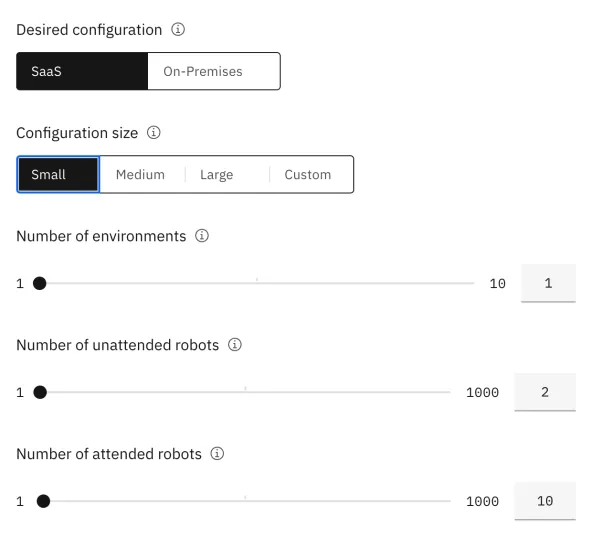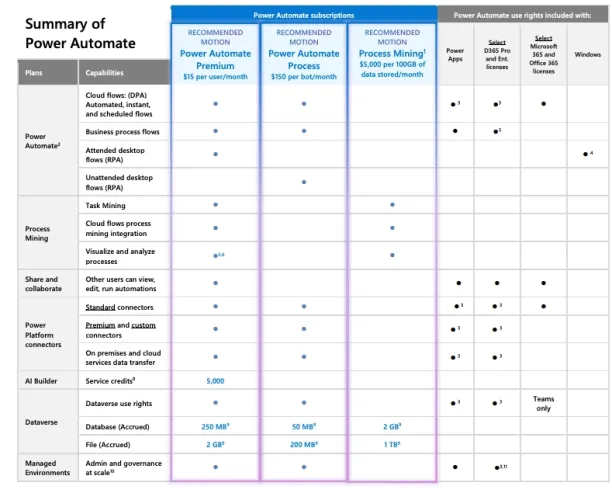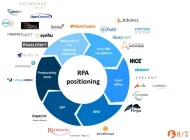RPA Pricing: Comparison of Leading RPA Vendors' Fees in 2024
Digital transformation is critical for a modern enterprise. 56% of CEOs say that digital improvements have led to increased revenues. RPA (robotic process automation) is one of the most used technologies to automate business processes.
However, calculating an RPA software’s TCO is complex because there are various factors that affect RPA pricing, such as:
- Deployment environment (e.g. cloud vs on-premise)
- Number of bots
- Type of bots
- Number of users
- Frequency of usage
Unfortunately, most RPA vendors, similar to other tech vendors, aren’t transparent about their RPA tools’ pricing after multiple sales calls. And miscalculating the cost can result in an RPA implementation with different or lower ROI than projections.
We gathered all the relevant, public data on vendors’ pricing models to save you time and effort and provide you with estimates of what you should expect to pay. However, note that our data is for basic RPA packages. So it’s less relevant for:
- Enterprises that can earn significant volume discounts
- Individual users that can rely on the limited but free community editions
Note: Vendors are sorted by pricing model complexity, starting from the simplest one. If you are looking for cost-effective RPA companies, read our whitepaper covering RPA solutions that cost less than $2,000/bot/year:
IBM
The basic package includes:
- 2 attended bots
- 1 unattended bot
- 1 RPA Studio for bot development
- OCR (optical character recognition) & IVA (interactive virtual agent) functionality
IBM is the only RPA vendor on our list with an ROI and cost calculator (Figure 1) that minimizes guesswork and lets users get the most accurate return on their RPA investment.

Automation Anywhere
Automation Anywhere’s pricing1 depends on the number of:
- Bots
- Bot utility (e.g. bot creator and control room) licenses
AA’s basic package for SMEs is the Cloud Starter Pack priced at $750/month. It includes:
- 1 bot creator
- 1 control room
- 1 unattended bot
Each additional unattended bot is $500/month; each attended bot is $125/month. So a company wishing to have 1 of each product is expected to pay $875.
UiPath RPA
UiPath’s pricing depends on the:
- Number of bots
- Level of support
UiPath offers two packages2 for SMEs:
- Pro package: 25 licenses, 1 attended bot, 1 unattended bot, 1 action center, and 1 orchestrator costing $420/month
- Enterprise package: 100 licenses, an undisclosed number of bots, along with Pro’s offerings and more.
Appian
Appian’s RPA platform contains: :
- Automation bots
- IDP (Intelligent Document Processing)
- Smart Services
- AI capability
- Business Rules
- Process mining
Their RPA packages come in three types and differ on the:
- Number of developers
- Number of end-users
- Usage frequency
- Usage mode (e.g. only-input-providing users pay less)
Those 3 packages specifically are:
- Standard package: It offers “admin access, development capabilities, and normal day-to-day functions” for $75/user/month
- Infrequent package: It costs $9/user/month. This is for users with a maximum of three 24-hour sessions each month
- Input-only package: This is for internal/external users “with the ability to submit forms/requests to the application,” for $2/user/month
Microsoft’s Power Automate (PA)
Microsoft PA’s pricing3 depends on:
- Number of developers (not only active developer users but also those who interact with the bots)
- Number of end-users and users whose data is accessed by the bot
- Number of bots (i.e. flows in Microsoft lingo) but this only applied to unattended bots
- Use of unattended bots
- Use of modules (e.g. AI Builder)
Use of premium connectors (to various systems like Adobe Creative Cloud[Update: Microsoft’s made it available on all packages in their latest update]
Figure 24 summarizes the pricing details:

Pricing for different companies
A table of prices for different sizes of companies having different numbers of bots can make it easier for you to get an idea of the license costs.
| Vendor | IBM RPA | Automation Anywhere | UiPath RPA | Microsoft Power Automation | Appian |
|---|---|---|---|---|---|
| Trial period | 30-day | 30-day | 60-day | 30-day | Yes, but unspecified. Requested from Appian. |
Monthly price for 1 developer & 30 users (1 attended
+ 1 unattended)
| $981 | $875 | $420 | $615*** | N/A**** |
Monthly price for 1 developer & 30 users (10 attended
+ 10 unattended)
| $5,665 | $6,500** | $4,200 | $1,965*** | N/A**** |
Monthly price for 10 developers & 1,000 users (10 attended
+ 10 unattended)
| $8,359 | $8,750* | $42,000* | $16,650*** | $2,750 - $19,450 - $75,750***** |
Monthly price for 10 developers & 1,000 users (100 attended
+ 100 unattended)
| $48,000 | $87,500* | $42,000* | $30,150*** | $2,750 - $19,450 - $75,750***** |
Note: We’ve made the following assumptions for each vendor:
*Buying 10x of the starter package provides 10x developer seats.
**$250 (for developer seat) + 10 (attended bots) x $500 + 10 (unattended bots) x $125
***We assumed that all employees are either users, or their data needs to be accessed by bots. So, everyone needs a license. This means volume is based on the total number of employees, who are developers and end users. Price per user is $15/month for attended RPA, and $150/month to purchase the Power Automate Process package which includes unattended automation5 This creates 2 scenarios:
- Scenario 1: End-users only use attended RPA
- Scenario 2: All end users either need to use or their data needs to be processed by unattended RPA bots
**** Appian’s pricing model has a policy of a minimum of 100 users.
***** Appian’s 3 classes and distribution of users need to be estimated to calculate pricing. In all cases, the number of developer users is provided by our assumptions. For non-developer users, we share 3 cases. These are arbitrary assumptions but we picked them to provide a more realistic case than the other 2 cases which show the extreme points of the pricing landscape:
- Case 1: All end users use the input-only package
- Case 2: 20% of users use the standard package 30% use the infrequent package, and 50% use the input-only package
- Case 3: All end users use the standard package
Disclaimers
This exercise is based on vendors’ publicly shared pricing data. Potential sources of errors include changes in vendors’ pricing models or our misunderstanding of vendor pricing. Please highlight such issues in the comments or by reaching out to us.
Note that the pricing we outlined may change significantly with respect to:
- The number of licenses: We provided only 4 combinations of number of employees and bots. Different combos can lead to drastically different costs
- Enterprise discounts: For larger purchases or for purchases by large companies, volume discounts could be applied to shared prices
- The pricing model was chosen by the buyer: For example, a company only looking to leverage unattended bots can use Microsoft’s Power Automate Process pricing model to have their installation priced per unattended bot and get completely different pricing compared to what we outlined above
- Distribution of attended and unattended bots: We assumed that buyers would buy an equal number of attended and unattended bots. Different distributions of bots would change prices significantly
- Use of premium components: Certain components require additional pricing.
For example, in the case of Microsoft, users need to pay additional fees to use the AI Builder or premium connectors[Update: Microsoft’s made it available on all packages in their latest update] - Operating environment: For example, cloud or on-premise. On-premise bots may be provided at a higher cost
For more on RPA
If you are interested in learning more about RPA, read:
- Top 53 RPA Tools, Vendors, & Solutions
- UiPath vs IBM RPA: Detailed Comparison of 13 Features
- 11 Steps to Successfully Implement RPA
- 7 Steps to Select the Best RPA Tool & Vendor
For an in-depth look into RPA use cases and best practices, download our RPA whitepaper:
And if you are looking to adopt an RPA solution, we have a data-driven list of RPA vendors prepared.
If you need more information about RPA pricing, please book a call. Happy to answer your questions if you can answer a couple questions about your AIMultiple experience. We are currently offering this service for businesses based in the US or EU.
This article was originally written by former AIMultiple industry analyst Bardia Eshghi and reviewed by Cem Dilmegani.
External links
- 1. “Automation Anywhere Advances its Industry-leading Cloud-native and Web-based RPA Platform With SaaS Solutions to Combat COVID-19” PR Newswire. May 13, 2020. Retrieved on April 18, 2023.
- 2. “Plans and Pricing” UiPath. Retrieved on April 18, 2023.
- 3. “Power Automate pricing” Microsoft. Retrieved on August 14, 2023.
- 4. “Microsoft Power Platform Licensing Guide.” Microsoft. 2023. Retrieved on August 14, 2023.
- 5. “Types of Power Automate licenses.” Microsoft. 1 August, 2023. Retrieved on 14 August, 2023.

Cem has been the principal analyst at AIMultiple since 2017. AIMultiple informs hundreds of thousands of businesses (as per similarWeb) including 60% of Fortune 500 every month.
Cem's work has been cited by leading global publications including Business Insider, Forbes, Washington Post, global firms like Deloitte, HPE, NGOs like World Economic Forum and supranational organizations like European Commission. You can see more reputable companies and media that referenced AIMultiple.
Throughout his career, Cem served as a tech consultant, tech buyer and tech entrepreneur. He advised businesses on their enterprise software, automation, cloud, AI / ML and other technology related decisions at McKinsey & Company and Altman Solon for more than a decade. He also published a McKinsey report on digitalization.
He led technology strategy and procurement of a telco while reporting to the CEO. He has also led commercial growth of deep tech company Hypatos that reached a 7 digit annual recurring revenue and a 9 digit valuation from 0 within 2 years. Cem's work in Hypatos was covered by leading technology publications like TechCrunch and Business Insider.
Cem regularly speaks at international technology conferences. He graduated from Bogazici University as a computer engineer and holds an MBA from Columbia Business School.
To stay up-to-date on B2B tech & accelerate your enterprise:
Follow on

Comments
Your email address will not be published. All fields are required.